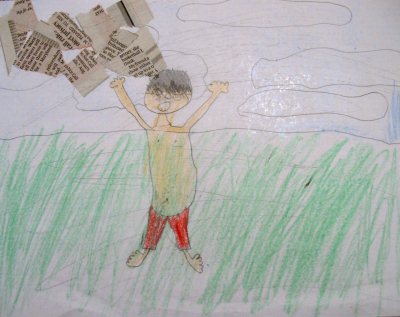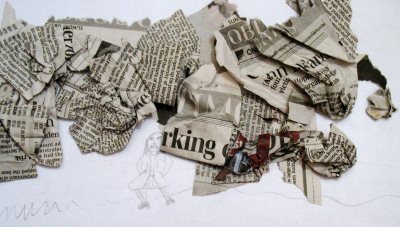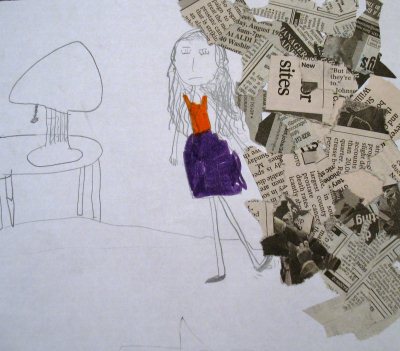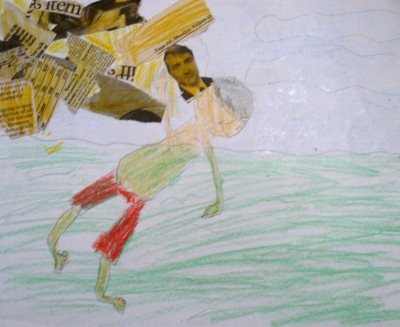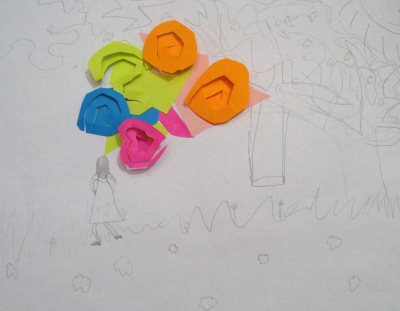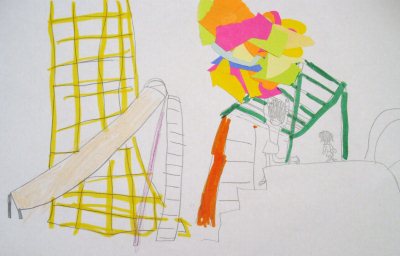The Art in Writing: Analysis of Two Different Types of Writing Samples
Jenna Loomis
For the past two years I have been exploring the use of global literature in my classroom and ways to help my students read and understand the meanings artists (illustrators) embed in their art to support and enhance the story. During this time my teammates and I have noticed a higher quality in our students’ writing when it is connected to global literature and art compared to when they are writing for other assignments.
I decided to analyze some of my students’ writing to better understand this difference. In this vignette I share my analysis of writing for two personal narrative writing assignments. For an overview of our literacy community and school community, please see the first vignette in this issue, “Learning about Ourselves and Others through Global Literature.” While I decided to do this analysis after my students had completed both writings, meaning there were differences in the contexts of the writings, I think my findings raise important issues for teachers to consider. The first assignment was the students’ art and writing in response to Sebastian’s Roller Skates (de Deu Prats, 2005) that I will call Art-Based Writing. The second was from the personal narrative writing prompt in the Houghton Mifflin Integrated Theme 5 Skills Test that I will refer to as Test-Based Writing. First, I will describe the two writing prompts and assignments and then discuss what I learned.
Two Writing Assignments
Art-Based Writing
The personal narrative based on the original artwork students created after reading Sebastian’s Roller Skates was the first of these two narratives we completed. The daily morning journal prompt read, “Tell about a time that you couldn’t do something you really wanted to do. Tell how you felt and what happened.” After writing, students read their response to a partner on the carpet and a few students shared with the class on the document camera.
We then read the beginning of Sebastian’s Roller Skates. In the beginning, young Sebastian has big ideas, but is very shy and lacks the confidence to share what he thinks and knows with adults in his life. Francesc Rovira, the artist, shows Sebastian’s lack of self-confidence and frustration by creating thought bubbles with black and white newspaper trailing from Sebastian’s mind. The phrase, “What Sebastian really wanted to say though, was that…” repeats throughout the beginning of the book.
I only read the first half of the book so students could connect to how Sebastian felt and focus on the newspaper illustrations, Rovira’s intent in creating those illustrations, and how the newspaper showed Sebastian’s feelings. I tied these feelings to the character x-rays (Short, 2009) that Laura discusses in her vignette. Students then created their own artwork that told a story about something they really wanted to do but couldn’t. They chose to use either what they had written about in their journals that morning or to use another idea that had been shared.
Below are three students’ illustrations. Joshua’s illustration shows when he was not able to pass the deep water test at his pool. Maia depicted a time when she was not able to do a sit-spin and Sophia’s illustration tells the story of when she really wanted to go to the park but her mother said, “No.”
Figure 1. Joshua’s illustration showing his attempt to pass the deep water test at his pool.
Figure 2. Maia’s illustration showing a time when she could not do a sit and spin.
Figure 3. Sophia’s illustration showing a time her mother refused permission to go to the park.
The second day, we read the rest of the book in which Sebastian finds a pair of roller skates and slowly learns to skate, although it is very difficult. As he improves, he gains confidence and pride in himself. He finds that he is able to do other difficult things, like talking to the adults and telling them what he thinks and knows. He is even able to talk to the little girl in his class who he thinks is very special! Rovira uses colorful paper in similar thought-bubble formation to show Sebastian’s feelings. My students created another picture to show when they could do what they weren’t able to in their first picture, using colorful paper in a similar way to Rovira.
Below is Joshua’s illustration of himself passing the deep water test when he devised a “secret” way; Maia’s illustration showing that she practiced so hard that she did the sit-spin; and, Sophia’s artwork depicting her finally playing at the playground.
Figure 4. Joshua’s illustration showing himself passing the deep water test.
Figure 5. Maia’s illustration showing how she practiced for the the sit and spin.
Figure 6. Sophia’s illustration showing her playing at the playground.
I decided to use the students’ art as “prewriting” for our personal narratives. Their stories were already well-developed in their imaginations from beginning to end, so additional prewriting was unnecessary. I provided a writing packet which included pages with lines for the beginning, middle and end. I also provided a Writer’s Checklist to clearly establish expectations. We completed the writing over three days, one for each part of the story.
Name:
Personal Narrative Checklist
☐ My story is about something I learned how to do or wanted to do.
Beginning
☐ My beginning starts with a description of the setting or dialog.
☐ My beginning tells what I wanted to do.
☐ I described my feelings when I could not do it.
Middle
☐ My middle tells what I did to be able to do it.
☐ My middle has at least 2 sentences.
End
☐ My end tells how I felt when I was able to do it.
☐ My end has at least 2 sentences.
Editing
☐ I checked for capitals.
☐ I used punctuation to break my ideas at the ends of sentences.
☐ I used my Words I Use dictionary to spell common words correctly.
Download the Writer’s Checklist
Test-Based Writing
The second personal narrative assignment was the Houghton Mifflin Integrated Theme Skills Test for Unit 5, part of our county reading program unit assessment. The prompt read:
“Think about your own life. Write a story about something special that happened to you. Remember to stick with just one story and use details to help the reader picture what happened. Plan your writing with a story map. Use the boxes on the next page. Draw what happened first, what happened next, and what happened last.”
I chose to give my students this part of the test on a different day from the reading and written response parts so they were fresh. Because this was a unit assessment, after reading the prompt, we did not share ideas. As with similar unit assessments, I gave them two minutes to sketch their ideas in the three-box organizer (beginning, middle, end). As they wrote, I put the writing checklist on the document camera so they could refer to it. I typically do not give my students a checklist for their writing on the test. I did it this time because the personal narrative was so close to the writing they had done ten days earlier for Sebastian’s Roller Skates and they had been so successful with using it then. Students were given as much time as needed to write and they could use additional paper if necessary. We completed this writing in one sitting.
Analyzing the Writing
To analyze these two writings I divided my students into three groups based on the writing I knew they typically produced. The groups and characteristics I used to create them are listed below:
Proficient (7 Students)
- Well-developed ideas with details and descriptions
- Focused writing
- Use of complex sentences (more than one verb or clause)
- Consistent sentence variety
Developing (6 Students)
- Some idea development
- Loss of focus at times, rambling, repetition or changing ideas
- More simple sentences, occasional complex sentences
- Some sentence variety
Emerging (6 Students)
- Little idea development
- Basic information communicated
- Simple sentences
- Little sentence variety
For each group, I analyzed the number of words students wrote and the craftsmanship of the students’ writing, which I discuss below.
Analyzing the Number of Words
I started by counting the number of words each student wrote. The chart below shows the mean number of words for each group and assignment.
|
Art-Based Writing (1st Writing: over 3 days) |
Test-Based Writing (3rd Writing: in 1 day) |
|
|
Proficient (7 students) |
85 |
48 |
|
Developing (6 students) |
87 |
57 |
|
Emerging (6 Students) |
59 |
21 |
Table 1. The Test-Based Writing was completed 10 days after the Art-Based Writing.
All students wrote significantly more for the Art-Based Writing. The difference in time, three days to write the Art-Based Writing and one to write the Test-Based Writing, was definitely a factor, as was the Writing Checklist for the Test-Based Writing being posted rather than provided to each student. Also, important is the substantial difference in the artwork and sharing that happened before each.
These supports and structures clearly had an impact, but those differences are normal in the life of a classroom. The writing students do on a test, for example, is often much less supported than other writing. That being the case, I began to consider which of the assignments gave a more accurate picture of a student’s abilities. Which showed what students, especially struggling writers, were capable of: Art-Based Writing or Test-Based Writing?
Daniel was in the Emerging Writers group. His writing below highlights the differences in students’ writing between the two assignments. (I corrected spelling and punctuation for readability.)
|
Daniel’s Art-Based Writing |
Daniel’s Test-Based Writing |
| “I wonder if I can play basketball,” I said. I asked them and they let me. It took a long time to get the ball into the basket, but I did it. I was happy I [scored]. I was happy when I made a new friend. | One day I was opening presents and my mom said, “It’s time to go.” |
Table 2. Comparison of Daniel’s Writing.
Analyzing the Craftsmanship of the Writing
Another way I reflected on the writing samples was to look at the craftsmanship of my students’ writing. To do this, I identified two different types of sentences. One described the sequence of events and the other told details about those events. If a compound sentence contained both sequence and details, I recorded those sentences once for each type.
The chart below summarizes my analysis of the craftsmanship of my students’ writing.
|
Art-Based Writing (1st Assignment: over 3 days) |
Test-Based Writing (3rd Assignment: in 1 day) |
|
|
Proficient (7 students)
|
|
|
|
Developing (6 students)
|
|
|
|
Emerging (6 Students)
|
|
|
Table 3. Craftmanship of Writing.
The data in the chart shows that in each group of writers, the sentences in the Test-Based Writing were considerably less detailed and descriptive, especially in the Emerging Writers group. Only one student in that group wrote a sentence giving a detail. Many of the Emerging Writers and a few Developing and Proficient Writers used the “first, next, last” formula. While “first, next, last” is a supportive structure for emerging writers, I know from the data that these students’ writing for the Test-Based Writing it is not an accurate assessment of what they are capable of as writers. For the Art-Based Writing, the Emerging Writers wrote an average of 3.3 sentences with details. This increase in the number of sentences with details is greater than the increase in the Proficient and Developing Writers’ samples.
Below is an example of how Kazia (Emerging Writers group) included more sentences with details in the Art-Based Writing:
|
Kazia’s Art-Based Writing |
Kazia’s Test-Based Writing |
| When I came to school I was really shy because it was scary. So I did not want to go to school. The next day I [brought] a teddy bear with me. And then the day after that I got used to it because I talked to people [who are] kids. And I talked to Mrs. Loomis. And then I got really used to it because I talked to everyone in the classroom. And then everyone talked to me. It made me feel surprised. | First I ate dinner with my family and then I listened to music with my sister. Then I go to sleep. And on the last page I go outside. |
Table 4. Comparison of Kazia’s Writing.
I wondered if my students could write with such details in their Art-Based Writing, why didn’t they produce that same quality of work for the Test-Based Writing? The difference in time (three days vs. one day) and the sharing were again key factors. Despite these differences, for both narratives the students had opportunities to think and plan before they wrote. While sketching the beginning, middle and end organizer for the Test-Based Writing intends to be helpful, upon reflection, it also seems to constrain students to think linearly. While narratives read linearly, the linear structure of the organizer did not encourage the richest ideas and inspirations for the young writers in my classroom.
For the art-based writing related to Sebastian’s Roller Skates, my students thought intentionally about lines, colors, and details to add to their drawings. Through this creative decision-making process, they formed descriptions in their minds that fed their writing. They were invested, felt a personal connection and purpose, and wrote the Art-Based personal narratives for themselves, not me. The same thinking, planning, and investment did not happen with the Test-Based Writing so my students’ writing was not as developed. They wrote the Test-Based Writing for me, not themselves.
The following are examples of student work, including the artwork that inspired students’ writing, their personal narrative stories, and the interviews in which students describe the details they have included in both. While not all students were able to articulate how their artwork inspired their writing, it is clear that the details they include in their artwork are present in their writing.
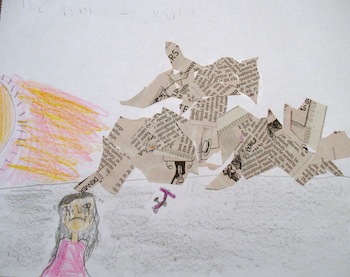 |
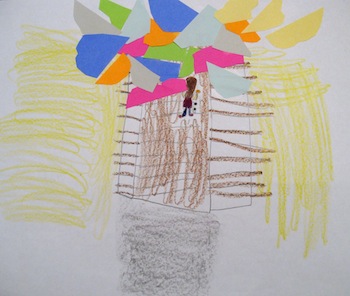 |
|
Figure 8. Examples of Alexis’ work. Interview with Alexis[cincopa AsCAxB7f77dD] |
|
Alexis wrote:
It was a beautiful spring day. Mom and I went out to try to ride my bike. I was nervous to ride my bike. I tried by myself. I did not get it. So I asked for help and my mom said, “I’ll help you Alexis.” We practiced until sundown and went home. Then on the boardwalk I did it. I was a little scared but really happy. Then we went to the beach and had happy hour after that.
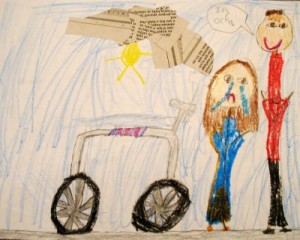 |
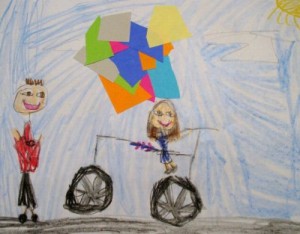 |
|
Figure 10. Examples of Julia’s artwork. Interview with Julia[cincopa AMEADBrQ7b1F] |
|
Julia wrote:
“I can’t do it!” said Julia. I cried and cried. I was really sad. “I’ll help you,” said Rolaend. “OK. I’ll try again to ride my bike,” said Julia. I tried again. My dad was holding me so I don’t fall. I tried to balance on my bike. I kept on practicing. “I did it!” shouted Julia. I felt very happy. I went for walks all the time. Now I can go super fast.
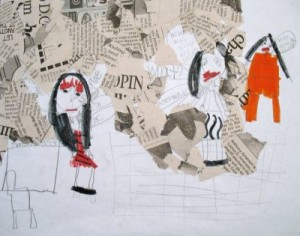 |
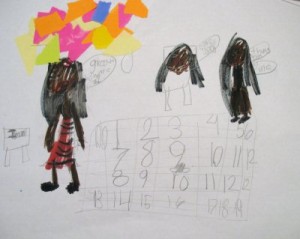 |
|
Figure 12. Examples of Imani’s artwork. Interview with imani[cincopa AsHA3D7v-XG4] |
|
Imani wrote:
On the first day of kindergarten school I was really shy to talk. When people said, “How are you today?” I would say, “Fine,” but they would not hear me. I would feel awkward because I could not talk. But then I told my mom and she said that she will take me somewhere that will teach me how to talk in front of people. It was somewhere in PA but the title of the place is teach you how to talk. It was pretty nice in there. Then when I came back to school I still feel like I can’t talk. But then when I went inside and someone said, “How are you today?” I said, “Extreme expert.” They would say, “That’s nice to hear from Imani.” I would say, “Yes, they can hear more now!”
Closing Thoughts
Throughout the years as my colleagues and I have been engaged in our work with art, literature, and writing, we have often remarked about what we thought was a noticeably higher-quality in our students’ work when it was connected to the art and the literature texts sets as compared to their writing for other assignments. The data I shared in this vignette was my effort to document whether that really was indeed the case and, if so, to explore and understand the factors that influence my students as they write.
As I detailed above, the Art-Based writing produced better quality writing than the Test-Based Writing in different areas. These findings were significant to me and to ensure that I support my students and get their best work in the future, I carefully considered and reflected on the factors influencing each writing experience. My reflections resulted in the following actions I am taking in my classroom:
•I am making sure that the writing topics are meaningful to my students so they develop a deep personal connection and have an authentic purpose for writing.
•I am providing adequate time so my students can develop each part of the assignment (e.g. focusing on the beginning of the story one day, the middle the next day and the end on the third day).
•I am offering a variety of prewriting experiences that encourage my students to think about and develop the details they will include in their writing.
•I am providing a variety of writing experiences over the year so that my students’ interests and creativity are peaked and challenged in different ways, allowing them to showcase their best work.
•I am assessing my students’ writing through different lenses rather than a single, test-based document.
My goal is to provide the support and motivation for all of my students to produce their highest quality work. Through my study I’ve learned the best ways to do that. As I plan my writing program in the coming years, connections to global literature and art will continue to be at the top of my list.
References
de Deu Prats, J. (2005). Sebastian’s Roller Skates. Illus by F. Rovira. La Jolla, CA: Kane/Miller.
Short, K. (2009). Critically reading the word and the world: Building intercultural understanding through literature. Bookbird: A Journal of International Children’s Literature, 47(2), 1-10.
Jenna Loomis teaches first grade at Pot Springs Elementary School in Maryland.
WOW Stories, Volume IV, Issue 5 by Worlds of Words is licensed under a Creative Commons Attribution-NonCommercial-ShareAlike 4.0 International License.
Based on a work at <a href="https://wowlit.org/on-line-publications/stories/iv5" target="_blank".

